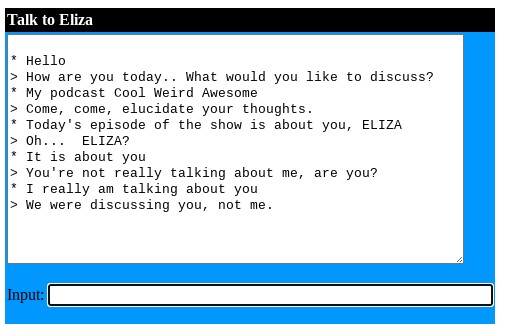Not a day goes by now where we don’t hear some new development about artificial intelligence.
There’s plenty to be concerned about, like deepfake videos and voices that could cause all kinds of trouble.
And there are clever ideas, like the people who used AI systems to write and produce a commercial for a bizarro-world pizza place called Pepperoni Hug Spot.
But for all its power and potential, generative AI still has a long way to go.
In fact, there have been some studies that find that people find ChatGPT less realistic than one of its most famous ancestors, the 1960s chatbot known as ELIZA.
This program was the work of Joseph Weizenbaum, who was then a professor at MIT.
Weizenbaum named the progam ELIZA after the character of Eliza Doolittle, who Henry Higgins was trying to present as a proper English lady in the play “Pygmalion” and the musical and movie “My Fair Lady.”
This ELIZA was also an illusion, since it couldn’t really communicate, but to its users, it really seemed like it could.
Remember that in the mid-1960s, most people didn’t interact with computers at all, and for those who did, the interactions weren’t super conversational.
Weizenbaum’s system changed that in a clever way.
ELIZA had very little background knowledge, but recognized a lot of the ways that humans have a conversation.
Its responses were designed to work sort of like a therapist, turning every question back toward the human participant.
If you typed in a statement like, say, “I really do like pie,” ELIZA might answer, “What does that suggest to you?”
It’s simple and straightforward, but Weizenbaum said students and staff were willing to share a lot with the program through these basic open-ended prompts.
Some were convinced that ELIZA was secretly a human instead of a computer.
Weizenbaum found all of this pretty concerning.
He thought people were too willing to trust tech, and eventually called artificial intelligence an “index of the insanity of our world.”
So not only did he create an AI model that still rings true today, he came up with some of the early criticism of AI models that also ring true today.
I wonder what ELIZA would think of all that!
The Super Bowl is just days away.
Before plays, you’ll often see teams huddling up.
The football huddle has roots in Gaulladet University, a famous higher ed institution for deaf and signing people.
The school says in 1894, during a game against another deaf team, quarterback Paul Hubbard tried to explain the next play to teammates without letting the opposition see his signing.
So they all got together in a tight circle, and football history was made.
Before ChatGPT, There Was ELIZA: Watch the 1960s Chatbot in Action (Open Culture)
When Gallaudet University Football Invented the Huddle (Gallaudet University)

